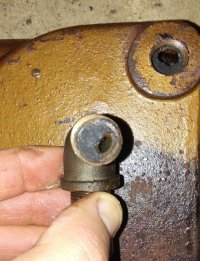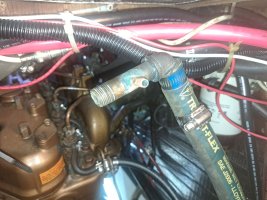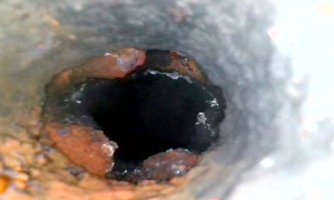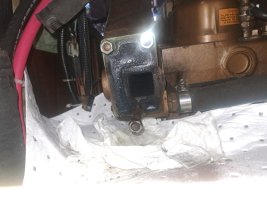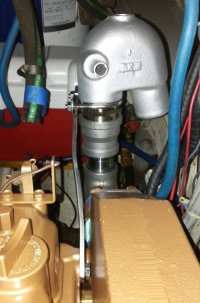We have overheating issues with our Universal 5432 and substantial amounts of steam mixed with the exhaust. I had a mechanic check the freshwater/coolant side of the heating system at the beginning of the summer and everything appears to be fine. When he sea-trialed the engine for an hour, it did not overheat. I have also checked the impeller and inspected the raw water strainer, both of which were fine. Over the summer I found that the amount of steam being generated seems higher than last summer. Temperature-wise it is fine for several hours, but eventually creeps up to around 200F, which I mitigated by throttling back and removing the engine cover. That got us through the summer. When I started the engine for a day trip last weekend, I noticed small amounts of soot initially mixed in with the exhaust stream. I viewed several of the threads in the forum on this maintenance issue (there are many!) and consulted Casey's maintenance book. Constriction in the exhaust elbow or related hoses seems to be a common problem and worth checking next. There is water coming out the exhaust, but with my limited experience I am not sure the volume is adequate. So now I am tackling the back-end, starting with the hoses from the heat exchanger to the raw water injector to the exhaust elbow, the exhaust elbow itself, and other associated hoses and connectors downstream.
I noticed a t-pipe connector between the heat exchanger and the raw water injection point at the exhaust elbow and I am unclear of its purpose. Both the 5432 service manual and E38-200 users manual appears mostly mum about the exhaust system and were no help about that fitting. A hose is connected at the T that appears to run to the exhaust thru-hull, and perhaps acts as a secondary outflow point for the raw water. I have also seen mention of an anti-siphon valve between the heat exchanger and exhaust elbow injection point, but the pictures don't seem to look like our setup. Before tearing things apart, I thought checking with folks on the forum might be able to identify what this is for.
Thanks.
Alan
I noticed a t-pipe connector between the heat exchanger and the raw water injection point at the exhaust elbow and I am unclear of its purpose. Both the 5432 service manual and E38-200 users manual appears mostly mum about the exhaust system and were no help about that fitting. A hose is connected at the T that appears to run to the exhaust thru-hull, and perhaps acts as a secondary outflow point for the raw water. I have also seen mention of an anti-siphon valve between the heat exchanger and exhaust elbow injection point, but the pictures don't seem to look like our setup. Before tearing things apart, I thought checking with folks on the forum might be able to identify what this is for.
Thanks.
Alan

